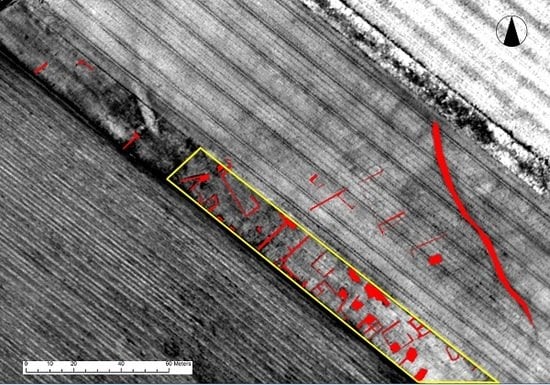An Objective Assessment of Hyperspectral Indicators for the Detection of Buried Archaeological Relics
Abstract
1. Introduction
2. Methodology
2.1. Spectral Indices
2.2. Mutual Information
3. Study Areas
3.1. Carnuntum
3.2. Selinunte
3.3. Ferai (Velestino)
4. Results
4.1. Carnuntum
4.2. Selinunte
4.3. Ferai (Velestino)
5. Discussion
6. Conclusions
Acknowledgments
Author Contributions
Conflicts of Interest
Abbreviations
| ARI | Anthocyanin Reflectance Index |
| ARVI | Atmospherically Resistant Vegetation Index |
| AVIRIS | Airborne Visible-Infrared Imaging Spectrometer |
| BAI | Burned Area Index |
| CARI | Chlorophyll Absorption Ratio Index |
| CH | Cultural Heritage |
| CRI | Carotenoid Reflectance Index |
| GARI | Green Atmospherically Resistant Index |
| GEMI | Global Environmental Monitoring Index |
| GSD | Ground Sampling Distance |
| MI | Mutual Information |
| NLI | Non-Linear Index |
| NDVI | Normalized Differential Vegetation Index |
| NIR | Near Infrared |
| nm | nanometers |
| PC | Principal Component |
| PCA | Principal Components Analysis |
| PRI | Photochemical Reflectance Index |
| SNR | Signal to Noise Ratio |
| SR | Simple Ratio |
| SWIR | Shortwave Infrared |
| VRE | Vogelmann Red Edge |
Appendix A
- reflectance value at x nanometers.
- mean value in the spectral range from to .
- number of spectral bands in the range from to .
- reflectance value at 470 nm.
- reflectance value at 550 nm.
- reflectance value at 650 nm.
- reflectance value at 860 nm.
| Rank C | Rank S | Index | Equation | Ref. |
|---|---|---|---|---|
| 26 | 31 | Anthocyanin Reflectance Index 1 | [44] | |
| 35 | 30 | Anthocyanin Reflectance Index 2 | [44] | |
| 12 | 8 | Atmospherically Resistant Vegetation Index | [30] | |
| 1 | 34 | Burned Area Index | [32,45] | |
| 25 | 21 | Carotenoid Reflectance Index 1 | [46] | |
| 28 | 29 | Carotenoid Reflectance Index 2 | [46] | |
| 18 | 20 | Difference Vegetation Index | [47] | |
| 22 | 9 | Enhanced Vegetation Index | [48] | |
| 11 | 19 | Global Environmental Monitoring Index | 0.75 , where | [38] |
| 17 | 14 | Green Atmospherically Resistant Index | [49] | |
| 16 | 32 | Green Difference Vegetation Index | [50] | |
| 14 | 24 | Green NDVI | [51] | |
| 5 | 26 | Green Ratio Vegetation Index | [50] | |
| 9 | 15 | Infrared Percentage Vegetation Index | [52] | |
| 30 | 23 | Iron Oxide | [53] | |
| 31 | 3 | Modified CARI | 0.8 0.2 | [54] |
| 19 | 6 | Modified CARI—Improved | [31] | |
| 29 | 7 | Modified Red Edge NDVI | [55] | |
| 20 | 5 | Modified Triangular Vegetation Index | [31] | |
| 4 | 33 | Non-Linear Index | [56] | |
| 24 | 2 | Normalized Difference Mud Index | [57] | |
| 13 | 28 | Normalized Difference Snow Index | [58] | |
| 10 | 16 | Normalized Difference Vegetation Index | [17] | |
| 36 | 25 | Photochemical Reflectance Index | [59,60] | |
| 27 | 12 | Plant Senescence Reflectance Index | [61] | |
| 7 | 13 | Red Edge NDVI | [62,63] | |
| 15 | 18 | Renormalized Difference Vegetation Index | [64] | |
| 3 | 22 | Simple Ratio | [33] | |
| 8 | 17 | Soil Adjusted Vegetation Index | [48] | |
| 33 | 36 | Structure Insensitive Pigment Index | [65] | |
| 34 | 27 | Sum Green Index | [66] | |
| 32 | 1 | Transformed CARI | [31] | |
| 6 | 11 | Transformed Vegetation Index | [47] | |
| 21 | 4 | Triangular Vegetation Index | [67] | |
| 23 | 10 | Visible Atmospherically Resistant Index | [68] | |
| 2 | 35 | Vogelmann Red Edge Index 1 | [34] |
References
- Keay, S.J.; Parcak, S.H.; Strutt, K.D. High resolution space and ground-based remote sensing and implications for landscape archaeology: The case from Portus, Italy. J. Archaeol. Sci. 2014, 52, 277–292. [Google Scholar] [CrossRef]
- Sarris, A.; Papadopoulos, N.; Agapiou, A.; Salvi, M.C.; Hadjimitsis, D.G.; Parkinson, W.A.; Yerkes, R.W.; Gyucha, A.; Duffy, P.R. Integration of geophysical surveys, ground hyperspectral measurements, aerial and satellite imagery for archaeological prospection of prehistoric sites: The case study of Vésztő-Mágor Tell, Hungary. J. Archaeol. Sci. 2013, 40, 1454–1470. [Google Scholar] [CrossRef]
- Crutchley, S.; Crow, P. The Light Fantastic: Using Airborne Lidar in Archaeological Survey; English Heritage: Swindon, UK, 2010. [Google Scholar]
- Chase, A.F.; Chase, D.Z.; Weishampel, J.F.; Drake, J.B.; Shrestha, R.L.; Slatton, K.C.; Awe, J.J.; Carter, W.E. Airborne LiDAR, archaeology, and the ancient Maya landscape at Caracol, Belize. J. Archaeol. Sci. 2011, 38, 387–398. [Google Scholar] [CrossRef]
- Evans, D. Airborne laser scanning as a method for exploring long-term socio-ecological dynamics in Cambodia. J. Archaeol. Sci. 2016, 74, 164–175. [Google Scholar] [CrossRef]
- Agapiou, A.; Hadjimitsis, D.G.; Alexakis, D.D. Evaluation of Broadband and Narrowband Vegetation Indices for the Identification of Archaeological Crop Marks. Remote Sens. 2012, 4, 3892–3919. [Google Scholar] [CrossRef]
- Cavalli, R.M.; Colosi, F.; Palombo, A.; Pignatti, S.; Poscolieri, M. Remote hyperspectral imagery as a support to archaeological prospection. J. Cult. Heritage 2007, 8, 272–283. [Google Scholar] [CrossRef]
- Doneus, M.; Verhoeven, G.; Atzberger, C.; Wess, M.; Ruš, M. New ways to extract archaeological information from hyperspectral pixels. J. Archaeol. Sci. 2014, 52, 84–96. [Google Scholar] [CrossRef]
- Aqdus, S.A.; Hanson, W.S.; Drummond, J. The potential of hyperspectral and multi-spectral imagery to enhance archaeological cropmark detection: A comparative study. J. Archaeol. Sci. 2012, 39, 1915–1924. [Google Scholar] [CrossRef]
- Lasaponara, R.; Leucci, G.; Masini, N.; Persico, R.; Scardozzi, G. Towards an operative use of remote sensing for exploring the past using satellite data: The case study of Hierapolis (Turkey). Remote Sens. Environ. 2016, 174, 148–164. [Google Scholar] [CrossRef]
- Agapiou, A.; Lysandrou, V.; Lasaponara, R.; Masini, N.; Hadjimitsis, D.G. Study of the Variations of Archaeological Marks at Neolithic Site of Lucera, Italy Using High-Resolution Multispectral Datasets. Remote Sens. 2016, 8, 723. [Google Scholar] [CrossRef]
- Datcu, M.; Seidel, K.; Walessa, M. Spatial Information Retrieval from Remote Sensing Images: Part A. Information Theoretical Perspective. IEEE Trans. Geosci. Remote Sens. 1998, 36, 1431–1445. [Google Scholar] [CrossRef]
- Cloude, S.; Pottier, E. An entropy based classification scheme for land applications of polarimetric SAR. IEEE Trans. Geosci. Remote Sens. 1997, 35, 68–78. [Google Scholar] [CrossRef]
- Hegarat-Mascle, S.L.; Vidal-Madjar, D.; Taconet, O.; Zribi, M. Application of shannon information theory to a comparison between L- and C-band SIR-C polarimetric data versus incidence angle. Remote Sens. Environ. 1997, 60, 121–130. [Google Scholar] [CrossRef]
- Du, H.; Chang, C.; Ren, H.; Chang, C.; Jensen, J.; D’Amico, F. New hyperspectral discrimination measure for spectral characterization. Opt. Eng. 2004, 43, 1777–1786. [Google Scholar]
- Suri, S.; Reinartz, P. Mutual-information-based registration of TerraSAR-X and Ikonos imagery in urban areas. IEEE Trans. Geosci. Remote Sens. 2010, 48, 939–949. [Google Scholar] [CrossRef]
- Rouse, J.; Haas, R.; Schell, J.; Deering, D. Monitoring Vegetation Systems in the Great Plains with ERTS. In Proceedings of the Third ERTS Symposium, NASA, Washington, DC, USA, 10–14 December 1973; pp. 309–317. [Google Scholar]
- Verhoeven, G.J. Near-infrared aerial crop mark archaeology: From its historical use to current digital implementations. J. Archaeol. Method Theory 2012, 19, 132–160. [Google Scholar] [CrossRef]
- Cover, T.M.; Thomas, J.A. Entropy, relative entropy, and mutual information. In Elements of Information Theory, 2nd ed.; Wiley: Somerset, UK, 2005; pp. 13–55. [Google Scholar]
- Neubauer, W.; Gugl, C.; Scholz, M.; Verhoeven, G.; Trinks, I.; Löcker, K.; Doneus, M.; Saey, T.; Van Meirvenne, M. The discovery of the school of gladiators at Carnuntum, Austria. Antiquity 2014, 88, 173–190. [Google Scholar] [CrossRef]
- Atzberger, C.; Wess, M.; Doneus, M.; Verhoeven, G. ARCTIS—A MATLAB Toolbox for Archaeological Imaging Spectroscopy. Remote Sens. 2014, 6, 8617–8638. [Google Scholar] [CrossRef]
- Doneus, M. Die Canabae von Carnuntum: eine Modellstudie der Erforschung römischer Lagervorstädte von der Luftbildprospektion zur siedlungsarchölogischen Synthese; Verlag der Österreichischen Akademie der Wissenschaften: Römische Limes, Österreich, 2013; Volume 47. [Google Scholar]
- Schmiedt, G. Applicazioni Della Fotografia Aerea in Ricerche Estensive Di Topografia Antica in Sicilia. Kokalos, Studi Pubblicati Dall’Istituto Di Storia Antica Dell’Università Di Palermo 1957, 3, 18–30. [Google Scholar]
- Rallo, A. Nuovi aspetti dell’urbanistica selinuntina. ASAtene 1984, 46, 81–96. [Google Scholar]
- Bequignon, Y. Recherches archèologiques à Phères de Thessalie; Les Belles Lettres: Paris, France, 1937. [Google Scholar]
- Doulgeri-Intzesiloglou, A. „Oι νεóτερες αρχαιoλoγικές έρευνες στην περιoχή των Aρχαίων Φερών.“ La Thessalie. Quinze années de recherches archéologiques 1975, 1990, 71–92. [Google Scholar]
- Dougleri Intzesiloglou, A. „Φεραί“. „Aρχαιoλoγία“ 1990, 34, 58–64. [Google Scholar]
- Hansen, M.H.; Nielsen, T.H. An Inventory of Archaic and Classical Poleis; Oxford University Press: Oxford, UK, 2004. [Google Scholar]
- Sarris, A.; Donati, J.; Kalayci, T.; Simon, F.; Manataki, M.; Garcia, C.; Cantoro, G. Amalgamation of Satellite Remote Sensing and Geophysical Prospection for the Investigation of Ancient Cities: Two Case Studies from Demetrias and Pherai at the Region of Magnesia, Thessaly, Greece. In Proceedings of the 8th Congress of the Balkan Geophysical Society, Chania, Greece, 4–8 October 2015. [Google Scholar]
- Kaufman, Y.; Tanre, D. Atmospherically Resistant Vegetation Index (ARVI) for EOS-MODIS. IEEE Trans. Geosci. Remote Sens. 1992, 30, 261–270. [Google Scholar] [CrossRef]
- Haboudane, D. Hyperspectral Vegetation Indices and Novel Algorithms for Predicting Green LAI of Crop Canopies: Modeling and Validation in the Context of Precision Agriculture. Remote Sens. Environ. 2004, 90, 337–352. [Google Scholar] [CrossRef]
- Chuvieco, E.; Martin, M.P.; Palacios, A. Assessment of Different Spectral Indices in the Red-Near-Infrared Spectral Domain for Burned Land Discrimination. Remote Sens. Environ. 2002, 112, 2381–2396. [Google Scholar] [CrossRef]
- Birth, G.; McVey, G. Measuring the Color of Growing Turf with a Reflectance Spectrophotometer. Agron. J. 1968, 60, 640–643. [Google Scholar] [CrossRef]
- Vogelmann, J.; Rock, B.; Moss, D. Red Edge Spectral Measurements from Sugar Maple Leaves. Int. J. Remote Sens. 1993, 14, 1563–1575. [Google Scholar] [CrossRef]
- Agapiou, A.; Alexakis, D.; Hadjimitsis, D. Evaluation of spectral sensitivity of ALOS, ASTER, IKONOS, LANDSAT and SPOT satellite sensors intended for the detection of archaeological crop marks. Int. J. Dig. Earth 2012, 7, 351–372. [Google Scholar] [CrossRef]
- Cavalli, R.M.; Betti, M.; Campanelli, A.; Cicco, A.D.; Guglietta, D.; Penna, P.; Piermattei, V. A methodology to assess the accuracy with which remote data characterize a specific surface, as a Function of Full Width at Half Maximum (FWHM): Application to three Italian coastal waters. Sensors 2014, 14, 1155–1183. [Google Scholar] [CrossRef] [PubMed]
- Trishchenko, A.P.; Cihlar, J.; Li, Z. Effects of spectral response function on surface reflectance and NDVI measured with moderate resolution satellite sensors. Remote Sens. Environ. 2002, 81, 1–18. [Google Scholar] [CrossRef]
- Pinty, B.; Verstraete, M. GEMI: A Non-Linear Index to Monitor Global Vegetation From Satellites. Vegetation 1992, 101, 15–20. [Google Scholar] [CrossRef]
- Agapiou, A.; Hadjimitsis, D.G.; Papoutsa, C.; Alexakis, D.D.; Papadavid, G. The Importance of Accounting for Atmospheric Effects in the Application of NDVI and Interpretation of Satellite Imagery Supporting Archaeological Research: The Case Studies of Palaepaphos and Nea Paphos Sites in Cyprus. Remote Sens. 2011, 3, 2605–2629. [Google Scholar] [CrossRef]
- Cavalli, R.M.; Pascucci, S.; Pignatti, S. Optimal Spectral Domain Selection for Maximizing Archaeological Signatures: Italy Case Studies. Sensors 2009, 9, 1754–1767. [Google Scholar] [CrossRef] [PubMed]
- Cavalli, R.M.; Licciardi, G.A.; Chanussot, J. Detection of Anomalies Produced by Buried Archaeological Structures Using Nonlinear Principal Component Analysis Applied to Airborne Hyperspectral Image. IEEE J. Sel. Top. Appl. Earth Obs. Remote Sens. 2013, 6, 659–669. [Google Scholar] [CrossRef]
- Agapiou, A.; Hadjimitsis, D.G.; Sarris, A.; Georgopoulos, A.; Alexakis, D.D. Optimum temporal and spectral window for monitoring crop marks over archaeological remains in the Mediterranean region. J. Archaeol. Sci. 2013, 40, 1479–1492. [Google Scholar] [CrossRef]
- Verhoeven, G.; Sevara, C. Trying to break new ground in aerial archaeology. Remote Sens. 2016, 8, 918. [Google Scholar] [CrossRef]
- Gitelson, A.; Merzlyak, M.; Chivkunova, O. Optical Properties and Nondestructive Estimation of Anthocyanin Content in Plant Leaves. Photochem. Photobiol. 2001, 71, 38–45. [Google Scholar] [CrossRef]
- Martin, M. Cartografia e Inventario de Incendios Forestales en la Peninsula Iberica a partir de Imagenes NOAA AVHRR. Ph.D. Thesis, Universidad de Alcalá, Alcalá de Henares, Spain, 1998. [Google Scholar]
- Gitelson, A.A.; Zur, Y.; Chivkunova, O.B.; Merzlyak, M.N. Assessing carotenoid content in plant leaves with reflectance spectroscopy. Photochem. Photobiol. 2002, 75, 272–281. [Google Scholar] [CrossRef]
- Tucker, C. Red and Photographic Infrared Linear Combinations for Monitoring Vegetation. Remote Sens. Environ. 1979, 8, 127–150. [Google Scholar] [CrossRef]
- Huete, A. Overview of the Radiometric and Biophysical Performance of the MODIS Vegetation Indices. Remote Sens. Environ. 2002, 83, 195–213. [Google Scholar] [CrossRef]
- Gitelson, A.; Kaufman, Y.; Merzylak, M. Use of a Green Channel in Remote Sensing of Global Vegetation from EOS-MODIS. Remote Sens. Environ. 1996, 58, 289–298. [Google Scholar] [CrossRef]
- Sripada, R. Aerial Color Infrared Photography for Determining Early In-season Nitrogen Requirements in Corn. Agron. J. 2006, 98, 968–977. [Google Scholar] [CrossRef]
- Gitelson, A.; Merzlyak, M. Remote Sensing of Chlorophyll Concentration in Higher Plant Leaves. Adv. Space Res. 1998, 22, 689–692. [Google Scholar] [CrossRef]
- Crippen, R. Calculating the Vegetation Index Faster. Remote Sens. Environ. 1990, 34, 71–73. [Google Scholar] [CrossRef]
- Segal, D. Theoretical Basis for Differentiation of Ferric-Iron Bearing Minerals, Using Landsat MSS Data. In Proceedings of the Symposium for Remote Sensing Environment, Fort Worth, TX, USA, 6–10 December 1982; pp. 949–951. [Google Scholar]
- Daughtry, C.; Walthall, C.; Kim, M.; De Colstoun, E.B.; McMurtrey, J. Estimating corn leaf chlorophyll concentration from leaf and canopy reflectance. Remote Sens. Environ. 2000, 74, 229–239. [Google Scholar] [CrossRef]
- Datt, B. A New Reflectance Index for Remote Sensing of Chlorophyll Content in Higher Plants: Tests Using Eucalyptus Leaves. J. Plant Physiol. 1999, 154, 30–36. [Google Scholar] [CrossRef]
- Goel, N.; Qin, W. Influences of Canopy Architecture on Relationships between Various Vegetation Indices and LAI and Fpar: A Computer Simulation. Remote Sens. Rev. 1994, 10, 309–347. [Google Scholar] [CrossRef]
- Bernstein, L.S.; Jin, X.; Gregor, B.; Adler-Golden, S. Quick Atmospheric Correction Code: Algorithm Description and Recent Upgrades. Opt. Eng. 2012, 51, 111719. [Google Scholar] [CrossRef]
- Riggs, G.; Hall, D.; Salomonson, V. A Snow Index for the Landsat Thematic Mapper and Moderate Resolution Imaging Spectrometer. In Proceedings of the Geoscience and Remote Sensing Symposium, IGARSS, Pasadena, CA, USA, 8–12 August 1994; Volume 94, pp. 1942–1944. [Google Scholar]
- Gamon, J.; Serrano, L.; Surfus, J. The Photochemical Reflectance Index: An Optical Indicator of Photosynthetic Radiation Use Efficiency Across Species, Functional Types and Nutrient Levels. Oecologia 1997, 112, 492–501. [Google Scholar] [CrossRef] [PubMed]
- Gamon, J.; Surfus, J. Assessing Leaf Pigment Content and Activity with a Reflectometer. New Phytol. 1999, 143, 105–117. [Google Scholar] [CrossRef]
- Merzlyak, J. Non-destructive Optical Detection of Pigment Changes During Leaf Senescence and Fruit Ripening. Physiol. Plant. 1999, 106, 135–141. [Google Scholar] [CrossRef]
- Gitelson, A.; Merzlyak, M. Spectral Reflectance Changes Associated with Autumn Senescence of Aesculus hippocastanum L. and Acer platanoides L. Leaves. J. Plant Physiol. 1994, 143. [Google Scholar] [CrossRef]
- Sims, D.; Gamon, J. Relationships between Leaf Pigment Content and Spectral Reflectance across a Wide Range of Species, Leaf Structures and Developmental Stages. Remote Sens. Environ. 2002, 81, 337–354. [Google Scholar] [CrossRef]
- Roujean, J.; Breon, F. Estimating PAR Absorbed by Vegetation from Bidirectional Reflectance Measurements. Remote Sens. Environ. 1995, 51, 375–384. [Google Scholar] [CrossRef]
- Penuelas, J.; Baret, F.; Filella, I. Semi-Empirical Indices to Assess Carotenoids/Chlorophyll-a Ratio from Leaf Spectral Reflectance. Photosynthetica 1995, 31, 221–230. [Google Scholar]
- Lobell, D.; Asner, G. Hyperion Studies of Crop Stress in Mexico. In Proceedings of the 12th Annual JPL Airborne Earth Science Workshop, Pasadena, CA, USA, 24–28 February 2003. [Google Scholar]
- Broge, N.; Leblanc, E. Comparing Prediction Power and Stability of Broadband and Hyperspectral Vegetation Indices for Estimation of Green Leaf Area and Canopy Chlorophyll Density. Remote Sens. Environ. 2000, 76, 156–172. [Google Scholar] [CrossRef]
- Gitelson, A.A. Vegetation and Soil Lines in Visible Spectral Space: A Concept and Technique for Remote Estimation of Vegetation Fraction. Int. J. Remote Sens. 2002, 23, 2537–2562. [Google Scholar] [CrossRef]
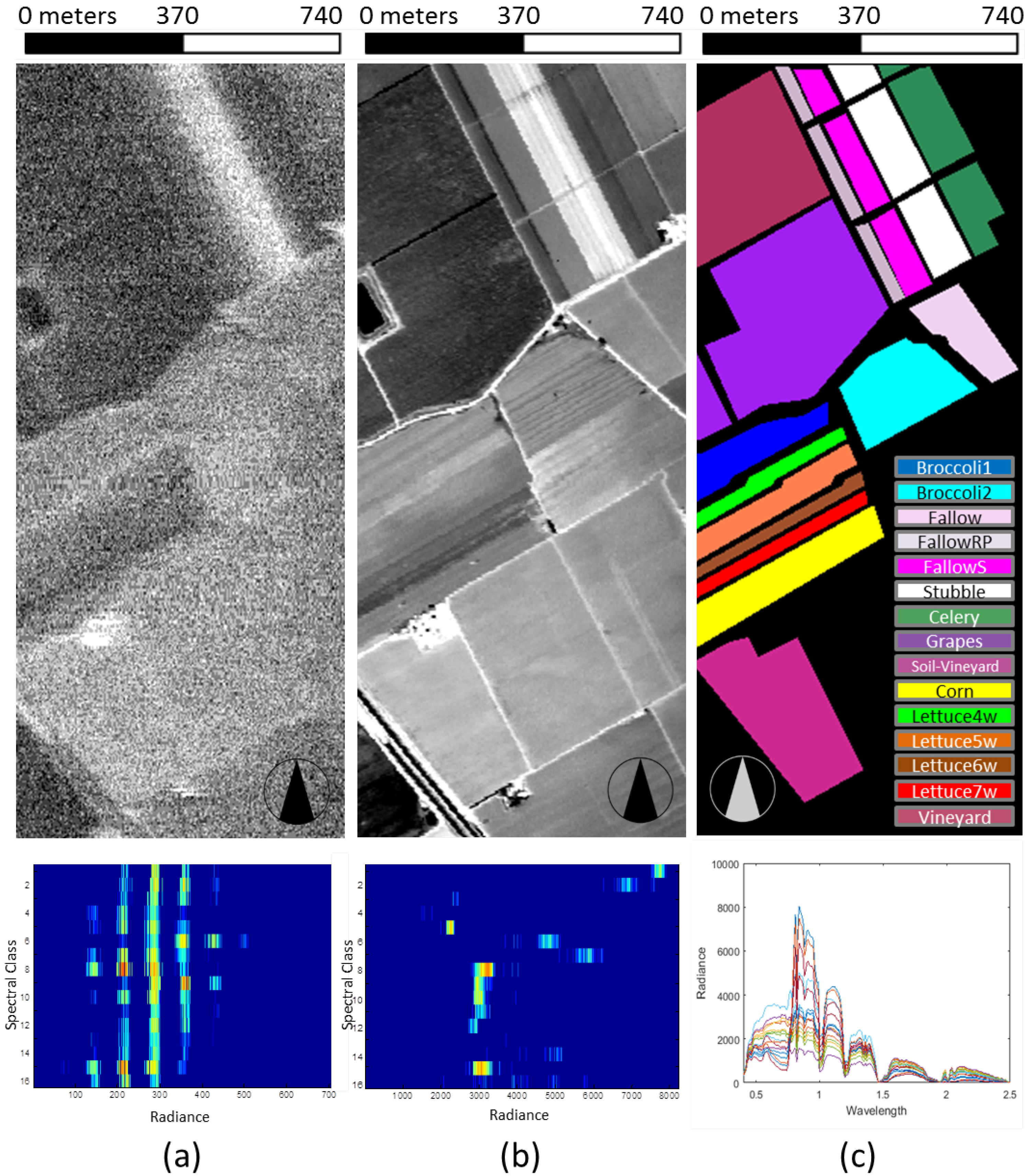
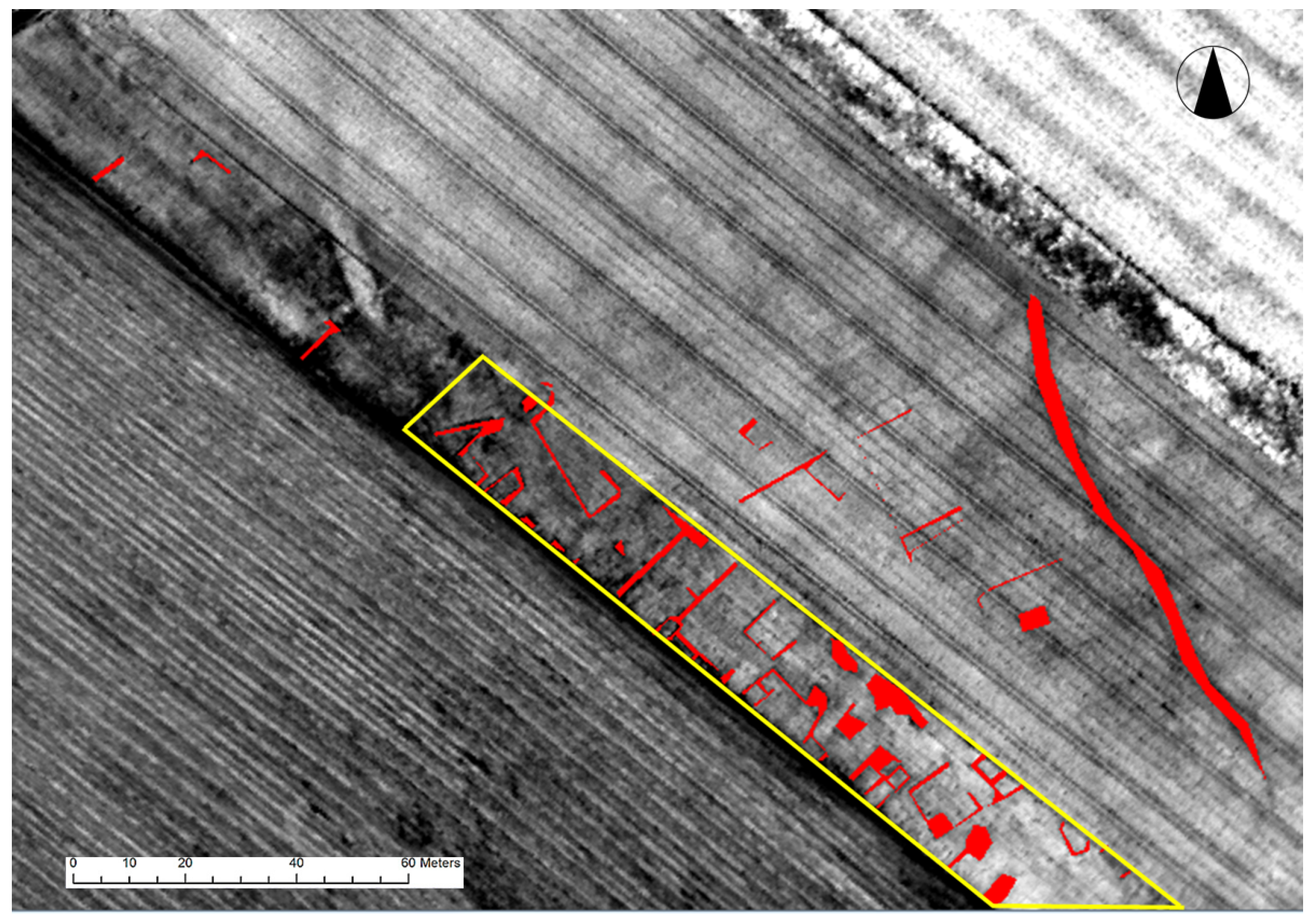
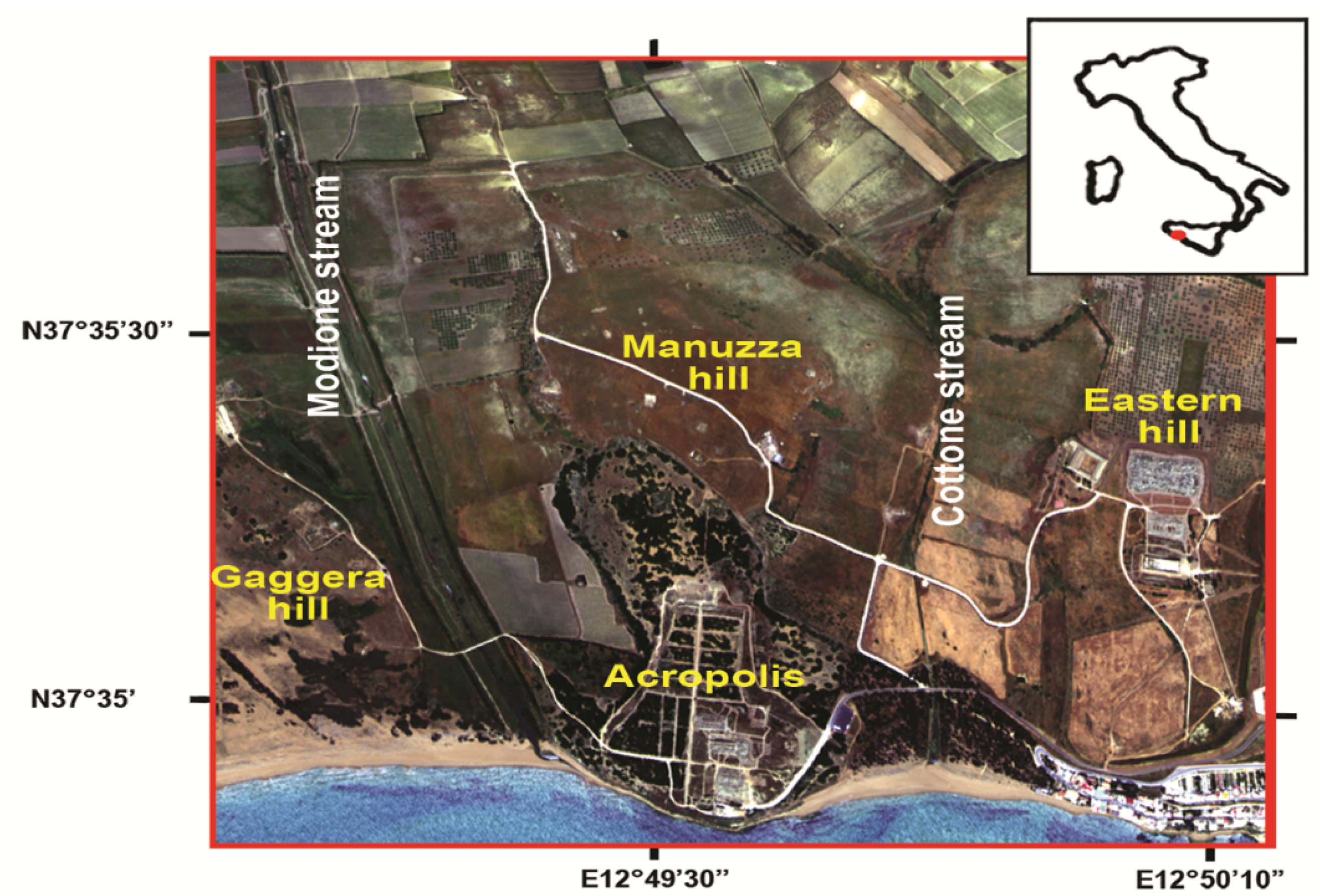
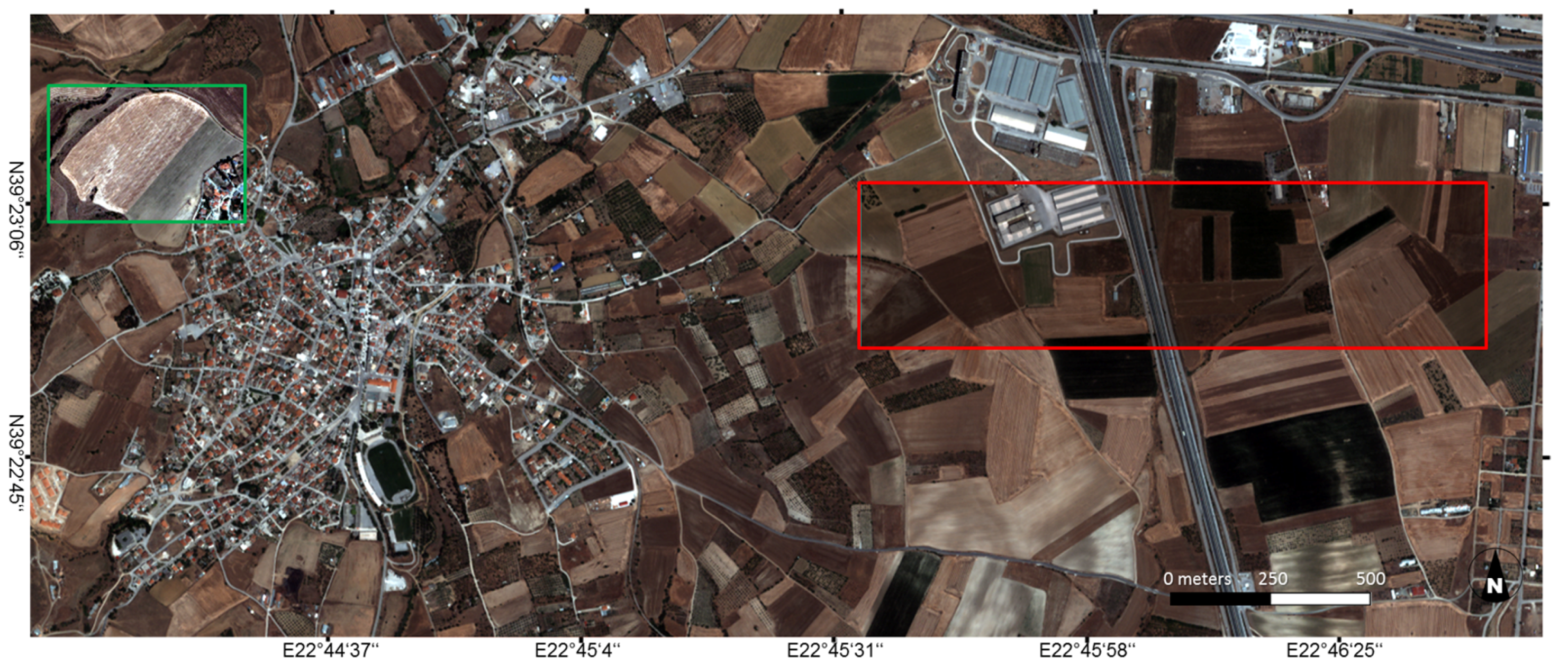
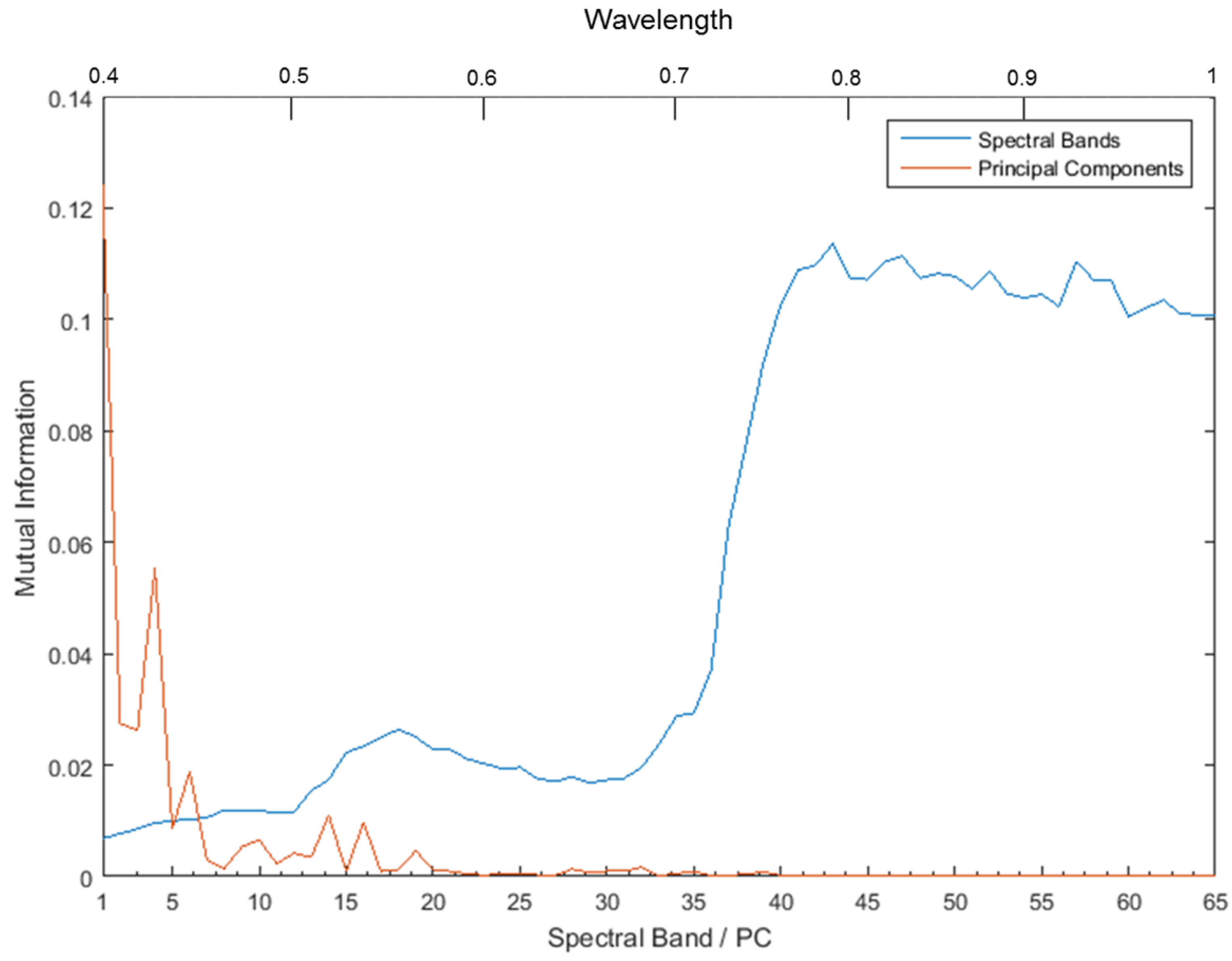
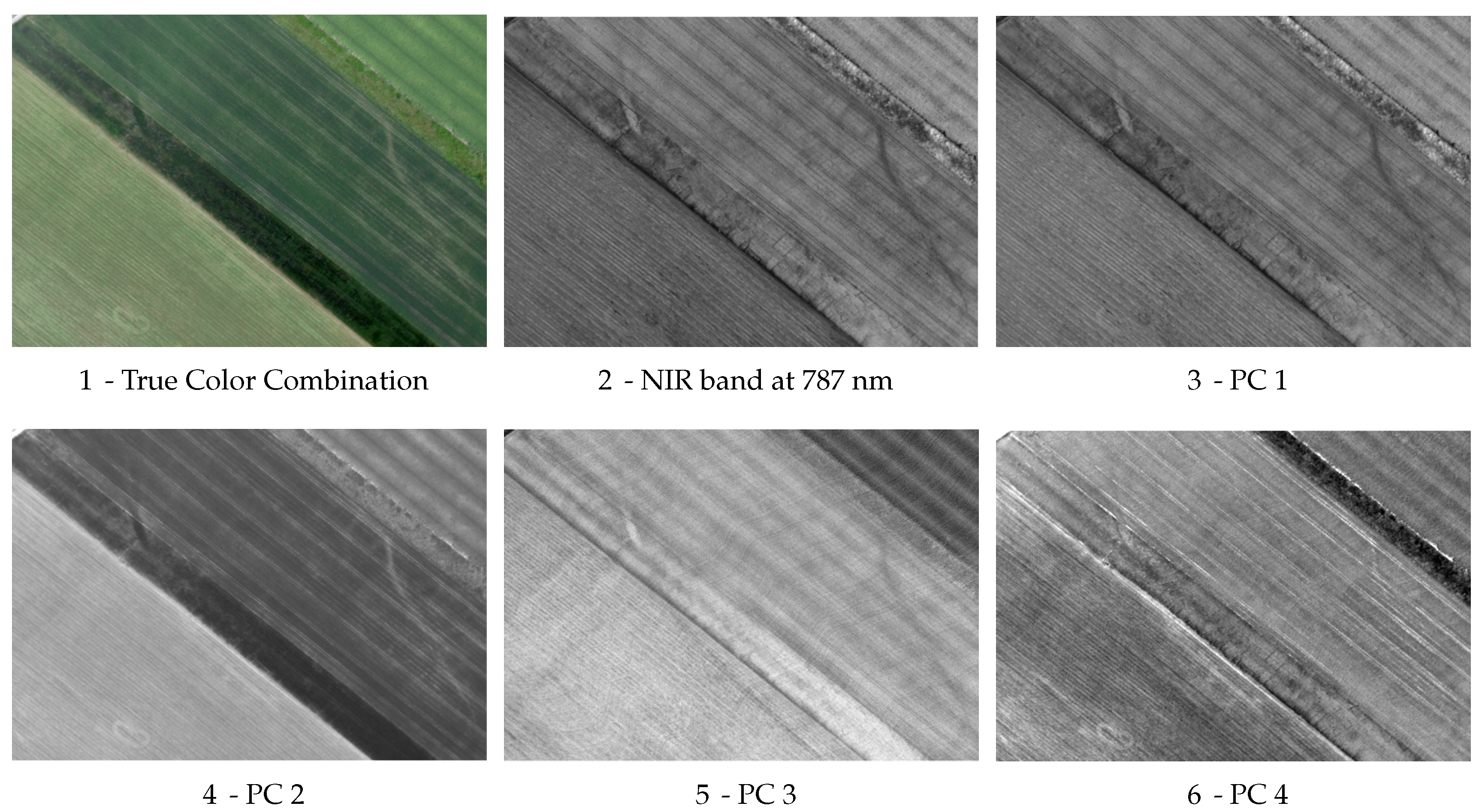
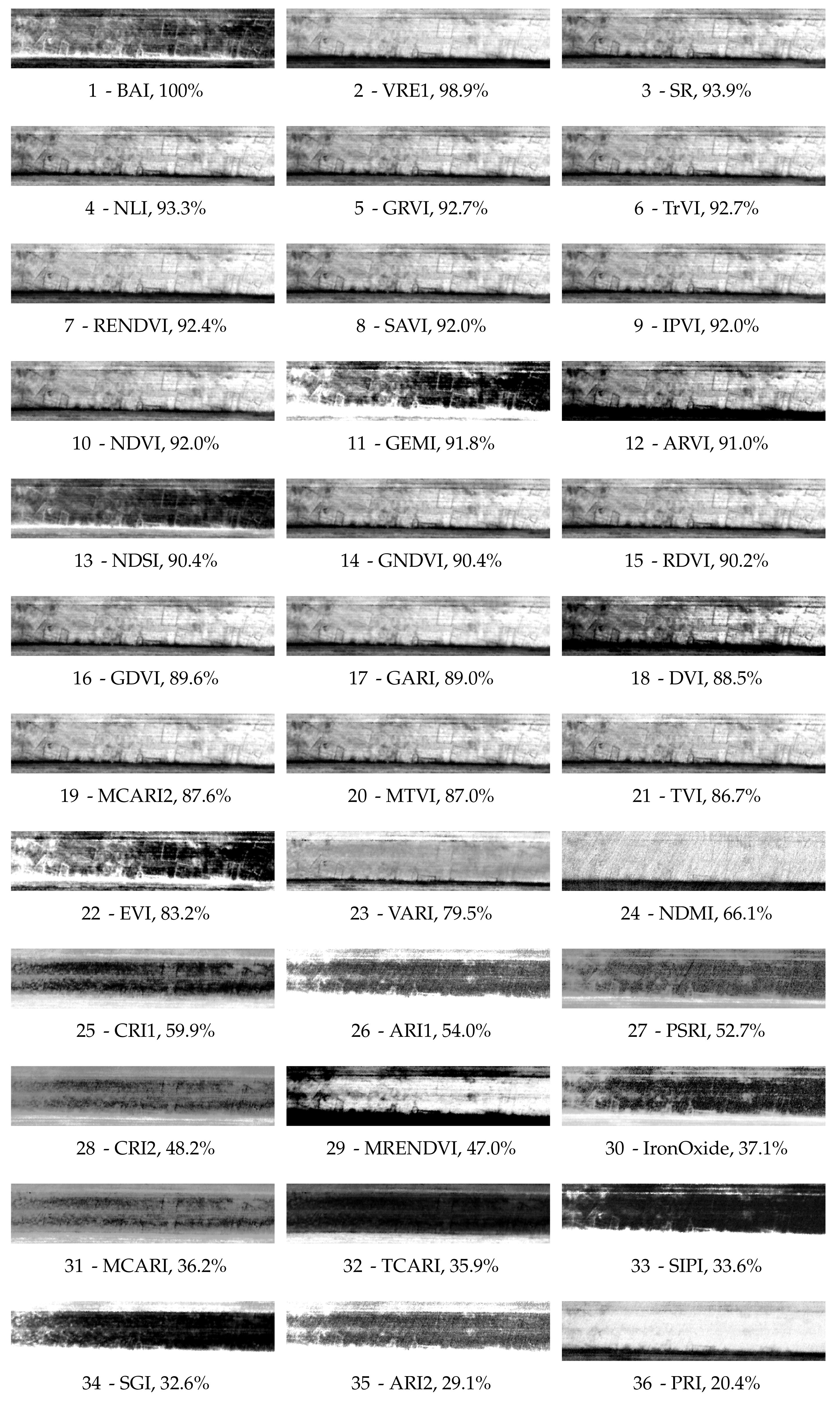
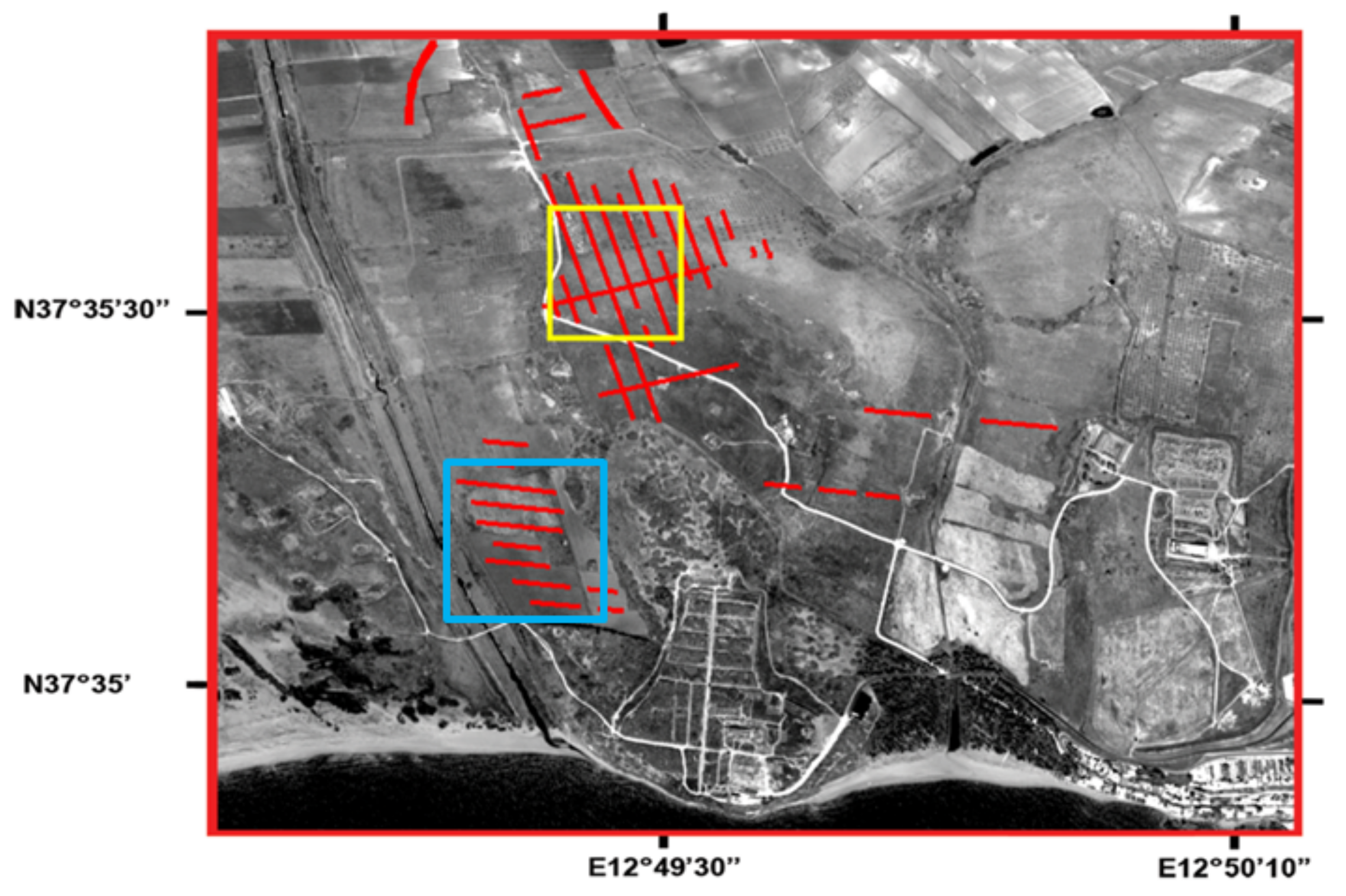
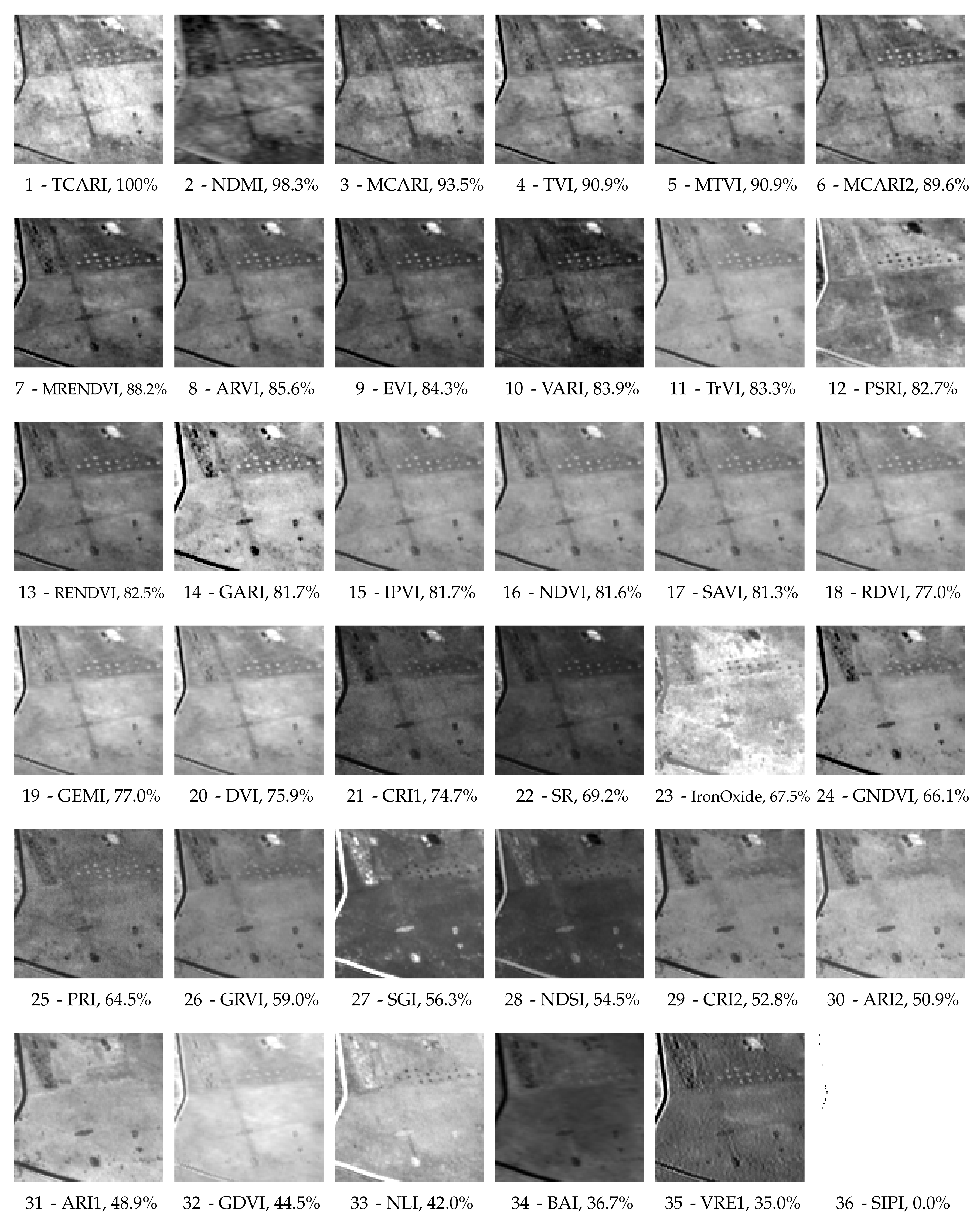
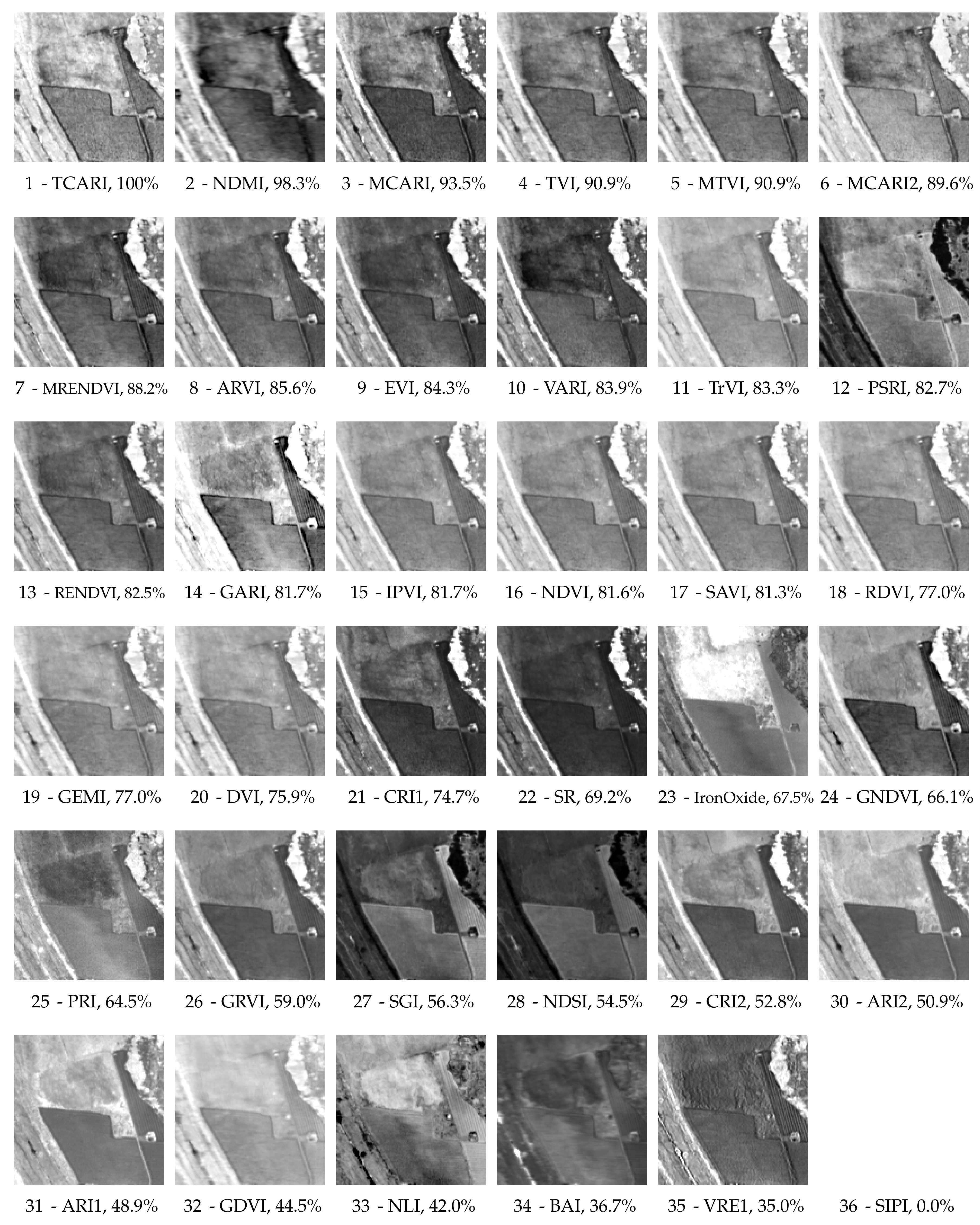
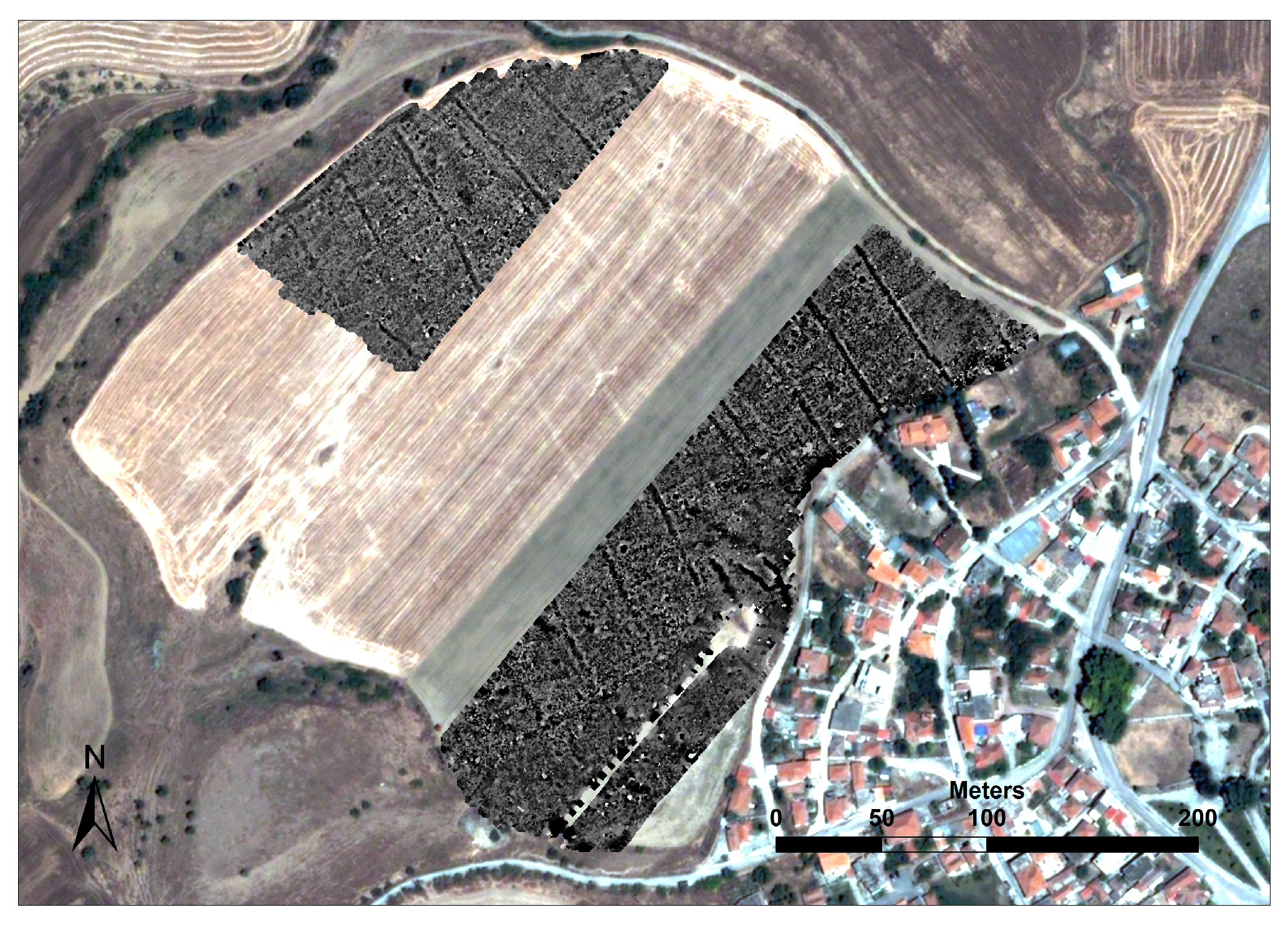
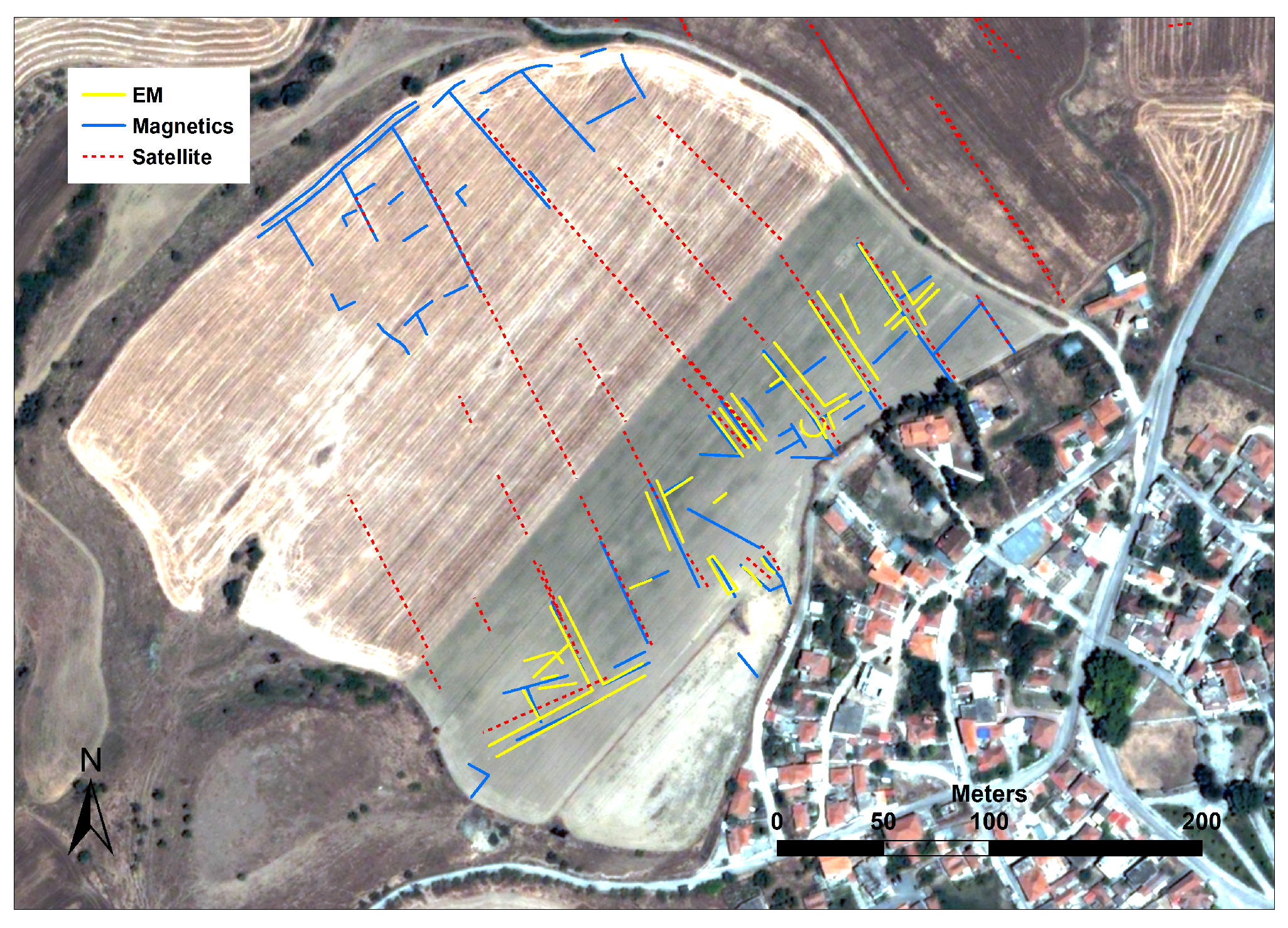
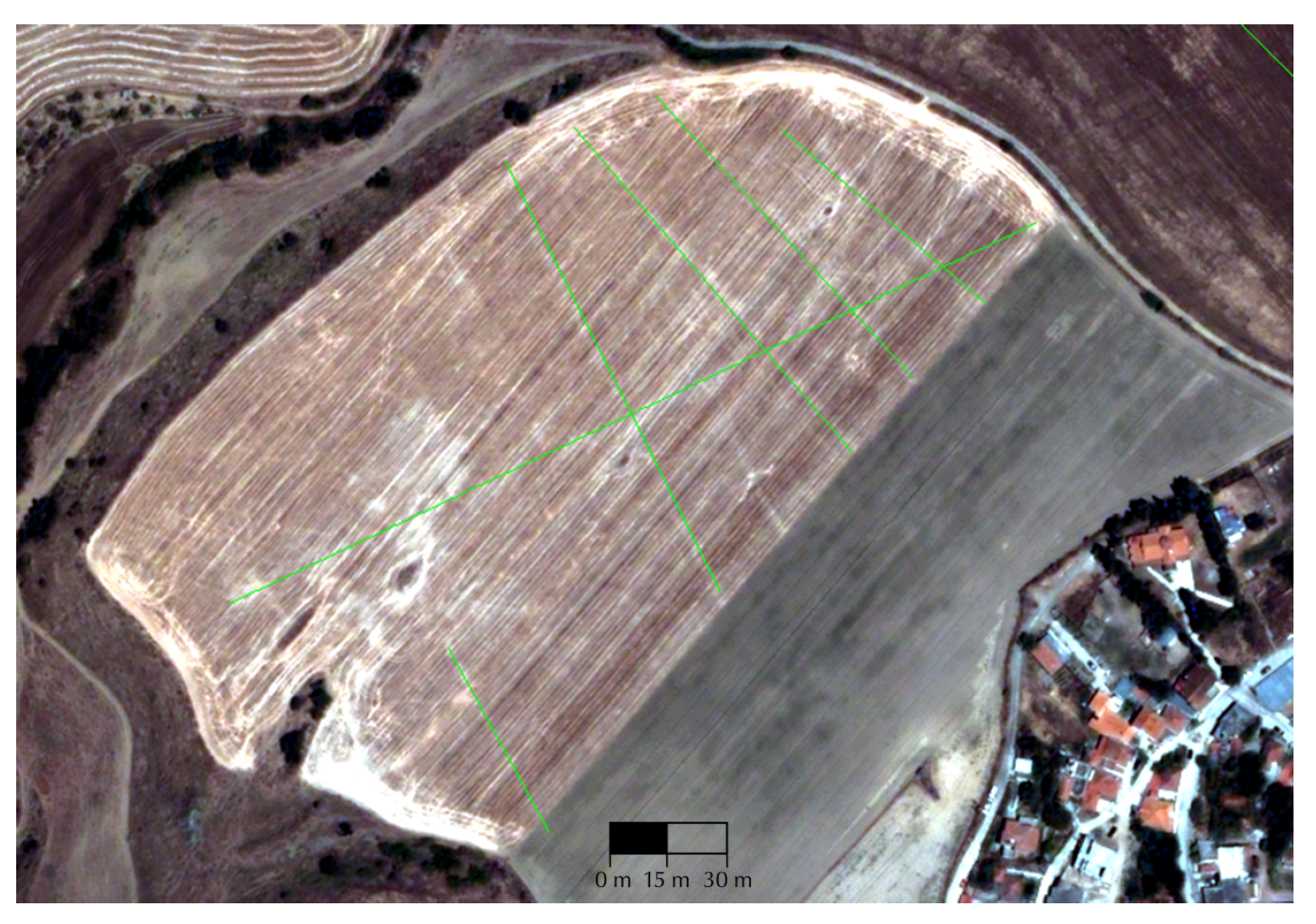
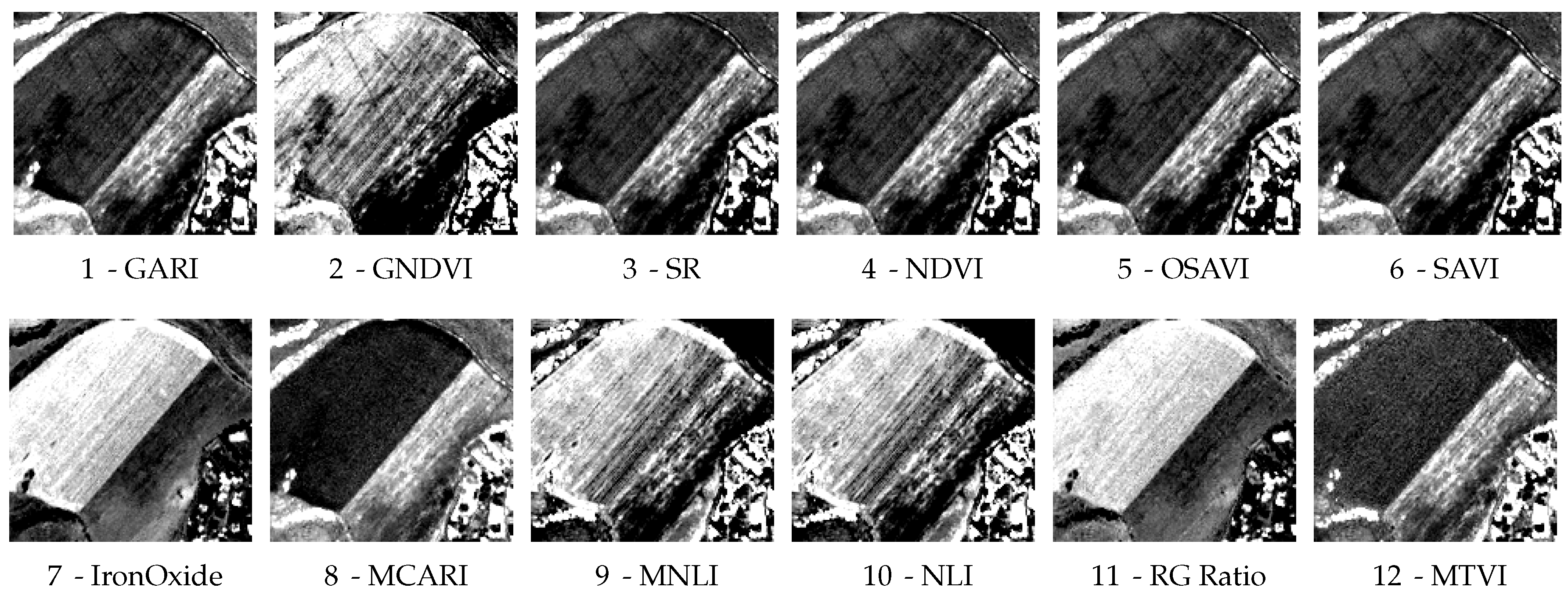

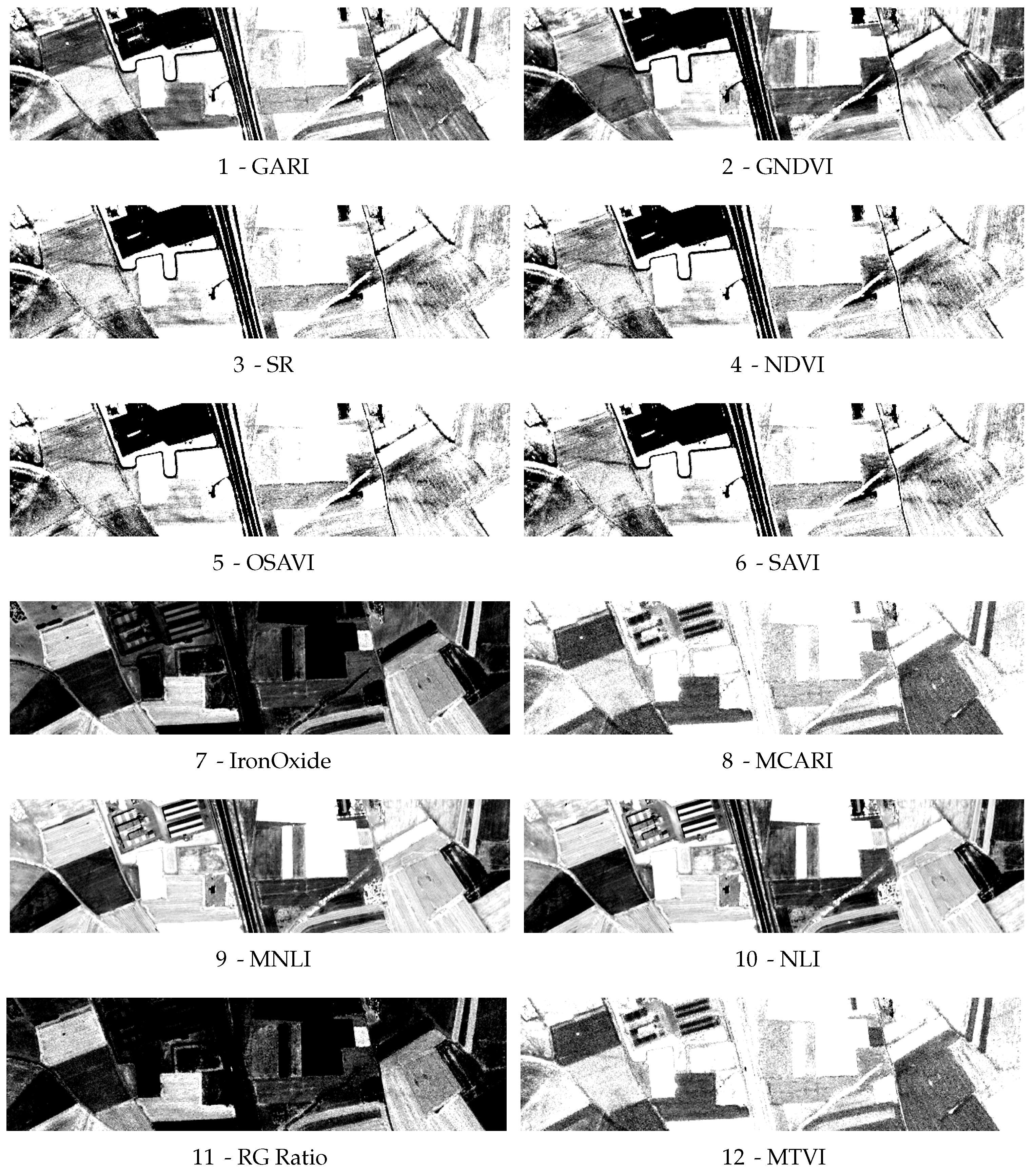
© 2018 by the authors. Licensee MDPI, Basel, Switzerland. This article is an open access article distributed under the terms and conditions of the Creative Commons Attribution (CC BY) license (http://creativecommons.org/licenses/by/4.0/).
Share and Cite
Cerra, D.; Agapiou, A.; Cavalli, R.M.; Sarris, A. An Objective Assessment of Hyperspectral Indicators for the Detection of Buried Archaeological Relics. Remote Sens. 2018, 10, 500. https://doi.org/10.3390/rs10040500
Cerra D, Agapiou A, Cavalli RM, Sarris A. An Objective Assessment of Hyperspectral Indicators for the Detection of Buried Archaeological Relics. Remote Sensing. 2018; 10(4):500. https://doi.org/10.3390/rs10040500
Chicago/Turabian StyleCerra, Daniele, Athos Agapiou, Rosa Maria Cavalli, and Apostolos Sarris. 2018. "An Objective Assessment of Hyperspectral Indicators for the Detection of Buried Archaeological Relics" Remote Sensing 10, no. 4: 500. https://doi.org/10.3390/rs10040500
APA StyleCerra, D., Agapiou, A., Cavalli, R. M., & Sarris, A. (2018). An Objective Assessment of Hyperspectral Indicators for the Detection of Buried Archaeological Relics. Remote Sensing, 10(4), 500. https://doi.org/10.3390/rs10040500






